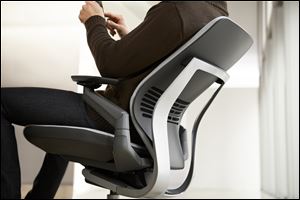
Steelcase’s chair ergonomic, but costly, common Gesture
9/14/2013
BLADE ILLUSTRATION BY WES BOOHER

The first time I had to buy a mattress, I remember being shocked at the cost. “Ah, but just remember,” the sales representative told me, “you’re going to spend a third of your life on it. Isn’t it worth investing in something you’ll use for a third of your life?”

Steelcase’s new Gesture chair, available for $980 later this fall, is definitely comfortable, but other high-end ergonomic office chairs deliver similar results for less cost.
When you think of it that way, maybe it’s not so crazy to spend $1,000 on a desk chair. You sit in that thing eight hours a day, too.
Actually, the term “desk chair” may be obsolete. That, anyway, is the conclusion Steelcase has reached after conducting what it says was a study of 2,000 people in 11 countries.
Steelcase says people don’t just sit upright in chairs anymore. In this age of phones, tablets, and laptops, people slouch, lean back, and curl up in all kinds of ways.
Nine new ways, in fact, to which the company has given names such as the Cocoon (reclining, feet on the seat, legs drawn in), the Take It In (slumped way back, arms relaxed while you watch a video) and the Strunch (a stretched hunch from chair edge to table, laptop pushed far away from you, chin propped up with nondominant hand).
According to Steelcase, if you don’t have the right chair, each of these new postures can lead to fatigue, pain, and injury. For example, hunching forward to see your laptop “leads to disc compression, excess pressure on the neck, and strain on the back and shoulders.” If your chair’s arms don’t support yours when you’re using the mouse for a long time, you can get “unnatural twisting of the wrists, hands, elbows, and shoulders.”
And you move around, shift, avoid hours in the same position. Otherwise, you could “decrease blood flow in the legs.”
The fruit of all this research, study, and philosophizing is the Steelcase Gesture chair, available later this fall for $980 (gulp). It’s supposed to be the ultimate work chair — “a new sitting experience,” the company asserts.
It certainly is comfortable. Both the seat and the back are deeply padded and expansive; you could even, if you wanted, sit with your legs tucked under you, or partly so.
And it certainly is adjustable. Like most office chairs, you can make this one taller or shorter by pressing a lever on the chair’s stem. The chair spins easily and rolls extremely easily on its five ball-bearing feet, which, as my 8-year-old can attest, is loads of fun.
The back can recline very far — farther than any Steelcase chair — without risk of toppling backward, which is never a good way to score points in the office. You can adjust the tension on the spring, too, so it goes back and forward more or less easily. You can lock the back into one of five angles by flipping a lever. All the controls are on the right side, below seat level.
By turning a knob, you can move the seat forward or backward relative to the back, to accommodate the longer or shorter of limb.
The armrests are miracles of mobility. By squeezing a lever under each one, you can move them independently up or down, inward or outward. And in any of these positions, you can rotate the armrests — nowhere near the “360 degrees” promised by the company, but perhaps 45 degrees.
The designers also put a lot of thought into where to end the chair’s various pieces. For example, the arms are short enough that they don’t get in the way when you want to pull up close to the table or desk. And the back doesn’t extend past your torso. It doesn’t block or restrict you when you turn to around to yell, “Hey, Frank! Do we have any C-120s in stock?”
Finally, a shout-out to whoever had the idea to wrap the padding all the way around all four sides of the seat’s edges. Suppose, for example, you wanted to assume a position that’s not among the Steelcase Nine. That’s entirely possible, thanks to this all-the-way-around padding; you can hang a limb over any of the seat’s edges without worrying about getting gangrene.
(Don’t try that with the famous Herman Miller Aeron chair. Its sharp, rigid seat edges could lop your leg right off.)
And, so, yes: This is a wonderful chair. It’s supremely comfortable, impressively adjustable, exceptionally supportive.
And yes, it’s also true that we work in weird new positions these days.
What’s not so clear is Steelcase’s claim that these two statements are connected.
In other words, just how much of a breakthrough is the Gesture chair? After you clear away the smoke from those arguments about our modern mobile gadgets, is the Gesture actually any more flexible than its rivals?
I made a pilgrimage to a couple of high-end office-furniture stores to find out. And here’s the baffling thing that I discovered: The Gesture is, at best, only a small advance.
It seems to be intended as a body blow at the Herman Miller Embody chair, which may not come with marketing materials about 2,000 people in 11 countries, but which you can adjust in nearly identical ways. The chair goes up and down, the seat goes forward and back, the back reclines a lot, the armrests go up and down and inward and outward.
The Gesture wins this round, though. The Embody chair costs much more ($1,300), and is slightly less adjustable; its armrests don’t rotate.
More mysteriously, the Gesture isn’t even that much of a leap beyond the Leap, Steelcase’s own earlier adjusto-chair and its most popular model. You can adjust the Leap in all the same ways as the Gesture — more ways, actually, because you can also move the armrests forward or back and adjust the lower-back firmness, and the seat glides forward as you lean back — but it costs $100 less.
The Leap is a more responsible choice, too: 94 percent of it is recyclable, and 30 percent of it is made of recycled material (well, “up to” 30 percent). It’s available in various colors of cloth or leather.
Now, the Gesture looks much more modern, much more sculptural, and much classier. It says “high-tech executive” more than “worker bee with sciatica.” But all that stuff about a “new sitting experience” — that’s clearly baloney.
And it’s possible to find nits to pick even with the Gesture. You can’t change the angle of the seat, if you care. There’s no headrest. And the armrests are hard plastic; a little cushioning wouldn’t hurt.
So, yeah, the company’s attempt to connect its conclusions — “we sit differently these days, and it’s healthy to shift positions often” — with its latest chair may reek of marketing department desperation.
But the conclusions themselves are sound. We do sit differently these days, and we should shift positions often.
Fortunately, plenty of chairs will serve you well in these departments. The Gesture is an excellent candidate, but so are the Leap, the Embody, and others. You don’t have to pay these steep, designery prices, either; many other ergonomic chairs, made with more plastic and fewer adjustments, are available in much lower price ranges.
The point is not that you should buy a Gesture chair. The point is that you should buy a good, comfortable, ergonomic chair.
After that, think of the life you’ll lead. You’ll have a terrific chair for eight hours of each day and a nice mattress for another eight hours. How you stay comfortable and healthy during the remaining eight is up to you.